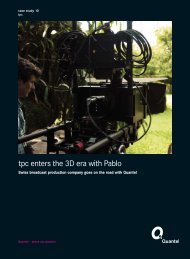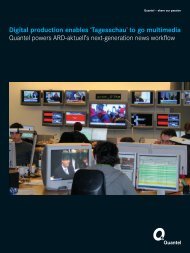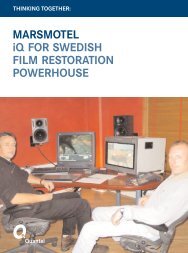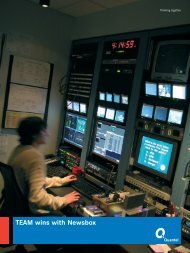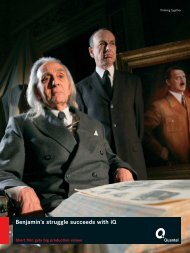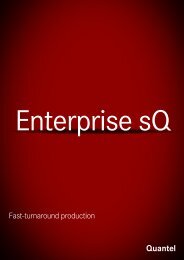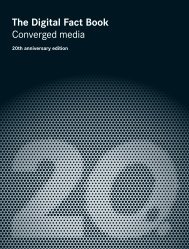You also want an ePaper? Increase the reach of your titles
YUMPU automatically turns print PDFs into web optimized ePapers that Google loves.
<strong>Canal</strong>+ goes HD… with <strong>Quantel</strong><br />
Thinking together
<strong>Canal</strong>+ goes HD… with <strong>Quantel</strong><br />
Etienne Robial has been the Artistic Director of <strong>Canal</strong>+ since its<br />
beginnings 22 years ago. He is heading up the project to design<br />
the new station branding for one of Europe’s leading pay-TV<br />
broadcasters. Robial’s team is working with the latest <strong>Quantel</strong> gQ<br />
graphic workstations, continuing a tradition that began in 1984<br />
when <strong>Canal</strong>+ revolutionised television graphics using the very first<br />
<strong>Quantel</strong> Paintboxes. Etienne Robial is the inventor of habillage;<br />
literally the ‘dressing up’ of television channels. In this article we<br />
look at how High Definition has become Haute Couture in Paris.<br />
On 4 th November 1984, a revolution occurred in the<br />
French media, with the birth of the country’s first<br />
pay-TV channel. Viewers were greeted with a black<br />
screen (reminiscent of a cinema just before the<br />
feature film is projected), gradually lighting up with a<br />
white diagonal line preparing the way for a rainbowcoloured<br />
ellipse and the letters of CANAL+. The eerie<br />
electro-acoustic music for these opening fireworks,<br />
in sharp contrast to the cutesy jingles and pastel<br />
graphics of the period, set the tone for what was to<br />
become – and remains – arguably the most<br />
sophisticated and provocative channel in Continental<br />
Europe (British viewers got a taste of the <strong>Canal</strong>+<br />
style when one of their star presenters, Antoine de<br />
Caunes, crossed the channel with Eurotrash).<br />
Etienne Robial, designer of the station branding sting<br />
and its avatars, explains his approach: “The <strong>Canal</strong>+<br />
design was intended from the start to give the<br />
channel a unique look and feel. We christened this<br />
signage system habillage.”<br />
To produce this original system, Robial discovered a<br />
machine which he felt could get the job done: the<br />
<strong>Quantel</strong> Paintbox. At the time, there was only one of<br />
these new systems in France, far from Paris in<br />
Angoulême, and the machine was pretty well booked<br />
solid. Robial decided to head for London, the city of<br />
one of his mentors, Martin Lambie-Nairn, founder of<br />
one of the UK’s most prestigious design studios and<br />
famous for his work on the BBC and Channel 4 logos.<br />
For six weeks, he settled in at pioneering facility The<br />
Moving Picture Company (MPC), working day and<br />
night (and mainly at night to obtain lower rates) to<br />
create his logo and hundreds of spin-offs for the<br />
start-up channel.<br />
From the start, <strong>Canal</strong>+ aired about 250 graphic<br />
sequences every day, constantly designing and<br />
adapting its branding and titling to attract viewers.<br />
Paris post facility UMT had just bought a Paintbox as<br />
<strong>Canal</strong>+ was reaching cruising speed. UMT would<br />
shortly thereafter buy France’s first <strong>Quantel</strong> HAL and<br />
Right: Etienne Robial, Artistic<br />
Director, <strong>Canal</strong>+.<br />
Far right: The first <strong>Canal</strong>+ logo,<br />
created on Paintbox.
Right: Florence Déchanet,<br />
freelance graphics artist and SFX<br />
editor, and Fasia Lamari, <strong>Canal</strong>+<br />
graphics artist.<br />
both machines were made available to Robial and his<br />
team, as was the <strong>Quantel</strong> Editbox a few years later<br />
when it first came out.<br />
Over the years, <strong>Canal</strong>+ adapted to changes in<br />
broadcast video with <strong>Quantel</strong> kit, moving from<br />
analogue to digital and from linear to non-linear<br />
systems. Robial unwaveringly remained loyal to<br />
<strong>Quantel</strong>, fighting off the software miracle merchants.<br />
“The problem with software-based systems,” says<br />
Robial, “is that they’re just too slow, they have<br />
trouble dealing with aliasing problems, they don’t<br />
give you a good freeze frame and they manage A to<br />
B transitions poorly. <strong>Quantel</strong> systems, technically<br />
and creatively, are clearly designed with the needs of<br />
editors and graphic designers in mind. They’re not<br />
piecemeal solutions that you string together hoping<br />
they’ll work. To make matters worse, software<br />
systems can be virus-ridden, which is a nightmare<br />
we can do without.”<br />
To make the leap into HD, Robial and his team<br />
looked at almost everything on the market and, after<br />
having considered different technical options and<br />
commercial offers, they decided to renew their<br />
confidence in <strong>Quantel</strong> with the new generation<br />
Paintbox gQ. Two machines have been installed and<br />
are churning out stunning graphics on a daily basis.<br />
Florence Déchanet, freelance graphic artist and<br />
special effects editor, was involved in the project to<br />
design and deploy specific HD work processes on<br />
the <strong>Quantel</strong> systems and to set up the templates. “To<br />
begin with, we had to manage the weight of HD and<br />
the different formats needed during the transition<br />
phase. Also, we wanted to maintain a well-oiled<br />
workflow process and translate the visual style guide<br />
into useable graphics, in both 16/9 HD and 4/3 SD.<br />
Colour management had to be controlled, to ensure<br />
that the results on viewers’ screens were in keeping<br />
with the initial design.”<br />
Right: Once upon a time, Zinedine<br />
Zidane had hair and played for<br />
Juventus.<br />
Far right: <strong>Canal</strong>+ billboards in<br />
Dutch.
Right: The new <strong>Canal</strong>+ habillage,<br />
produced on <strong>Quantel</strong>’s gQ.<br />
To deal with this complexity, <strong>Canal</strong>+ installed an HD<br />
oscilloscope and simultaneous HD/SD monitoring to<br />
check results in all formats. Once these technical<br />
problems were resolved, flexible work methods were<br />
implemented.<br />
“With this base,” says Florence Déchanet, “we had<br />
the ability to play around with the templates, while<br />
continuing to respect the colour principles and the<br />
style guide. We then went on to the editing phase,<br />
based on an audio template. A musician came in to<br />
pace each sequence on a timeline. Alternating black<br />
and white segments on parallel tracks made it easier<br />
to introduce prefabricated material into each clip.<br />
This is where having the metadata with the history of<br />
each element made it easier to edit and make<br />
changes as needed.”<br />
Once the editing was complete, the editor produced<br />
an international version, used in France and then<br />
adapted to the other <strong>Canal</strong>+ countries and<br />
languages. It was therefore essential to have a<br />
workable archiving and retrieval system and to have<br />
a consistent style guide for adaptations.<br />
“It’s true that these various upstream development<br />
stages took time and that the best solutions didn’t<br />
necessarily jump off the screen on Day 1,” concludes<br />
Florence Déchanet, “but this exploration phase was<br />
one of the most interesting and creative parts of the<br />
process. Having the right tools was a key to produce<br />
the quality and quantity required for this project,<br />
while respecting very tight deadlines. We produced<br />
over 300 useable sequences on the <strong>Quantel</strong> kit,<br />
which definitely lived up to expectations and allowed<br />
us to get this very complex and creative job done<br />
properly.”<br />
Fasia Lamari, a graphic artist who has been working<br />
with Robial (and <strong>Quantel</strong> equipment) for over 20<br />
years, appreciates “the ergonomics and precision of<br />
the new generation <strong>Quantel</strong> systems. The <strong>Canal</strong>+<br />
Right: <strong>Canal</strong>+ in Russia.<br />
Far right: This reads SPORT.
Right: The PSG logo, created by<br />
Etienne Robial.<br />
habillage system is an intelligent and economical<br />
Lego kit, which takes the technical hassles out of the<br />
creative process. Our main challenge as we went to<br />
HD was to maintain our work methods, based on the<br />
fabrication of very precise templates, useable in all<br />
SD and HD formats and aspect ratios (4/3, 16/9<br />
and letterbox). We opted for Version 3.5 of the<br />
<strong>Quantel</strong> system from the start (in the spring of<br />
2006), which really made it easy to manage our HD<br />
graphics. Our workflow stood up to the test of these<br />
new challenges and constraints. Etienne Robial<br />
created the basic graphic design and templates, and<br />
we applied these to all formats. For everything to<br />
come together just right, you have to have all the<br />
editing, FX, grading and audio tools available and<br />
<strong>Quantel</strong> puts all of these into a single machine. The<br />
ergonomics are really efficient and we can really get<br />
down to the pixel level.”<br />
“As we enter full speed into the HD era,” concludes<br />
Robial, “we need precision and harmony more than<br />
ever and we’re seriously looking at how our work on<br />
screen can be applied elsewhere. With <strong>Quantel</strong><br />
systems, we’re really looking at a multi-format and<br />
multi-media world.”<br />
“As we enter full speed into the HD era, we need precision and harmony<br />
more than ever and we’re seriously looking at how our work on screen can<br />
be applied elsewhere. With <strong>Quantel</strong> systems, we’re really looking at a multiformat<br />
and multi-media world.”<br />
-Etienne Robial
2030-00-00 04.04<br />
Right: <strong>Canal</strong>+ graphics air in<br />
several languages.<br />
Tailor-made television graphics<br />
In May 2006, at a ceremony in Vienna, Etienne<br />
Robial, Artistic Director of <strong>Canal</strong>+, became the first<br />
recipient of the Promax/BDA EMEA Award for<br />
Outstanding Achievement.<br />
Presenting the Award, Carmen Alzer, Senior Vice<br />
President and Managing Director, Promax/BDA<br />
EMEA declared: “Unquestionably, throughout his<br />
remarkable career and most certainly during his 22<br />
years as Artistic Director of <strong>Canal</strong>+, Etienne Robial<br />
has made an indelible mark on the European design<br />
and marketing communities, if not the entire industry<br />
worldwide.”<br />
Etienne Robial’s well-deserved award is the crowning<br />
achievement of his career, based on hard work,<br />
creativity and precision. Every single detail of the<br />
<strong>Canal</strong>+ identity, on and off screen, has been<br />
meticulously thought out and produced with almost<br />
fanatical devotion, without ever forgetting the<br />
aesthetics and fun that go into branding a maverick<br />
channel like <strong>Canal</strong>+. He dresses television like a<br />
fashion designer and mixes ingredients like a great<br />
chef.<br />
“You know, when I claim I invented the notion of<br />
habillage, I’m not trying to be pretentious. In fact, the<br />
whole thing was very down to earth. In 1984, Pierre<br />
Lescure, Managing Director of <strong>Canal</strong>+, asked me to<br />
create a logo for the new pay-TV channel. We were<br />
on a very tight budget at the time and we had to find<br />
a clever system to distinguish ourselves from<br />
established broadcasters on a 24/7 basis. To meet<br />
all these constraints, I came up with the idea of a<br />
graphics wardrobe and I remember explaining to<br />
Pierre Lescure that he could go into this virtual<br />
closet and chose different graphic elements the way<br />
he would choose a suit, a shirt and a tie. The idea<br />
was to have enough clothes and accessories for<br />
different occasions. The term habillage, which the<br />
Americans have adopted, had very humble<br />
beginnings.”<br />
Etienne Robial has designed the logos and visual<br />
style systems for several other French TV channels,<br />
including La Sept, M6, Show TV, i>télé, RTL-TV and<br />
RTL 9. He is also the creator of the Paris PSG football<br />
club logo and several other logos, including G7 Taxis,<br />
the Parc des Princes and the CNC (the French Film<br />
Board).<br />
www.quantel.com<br />
2127-56-502 09-06



